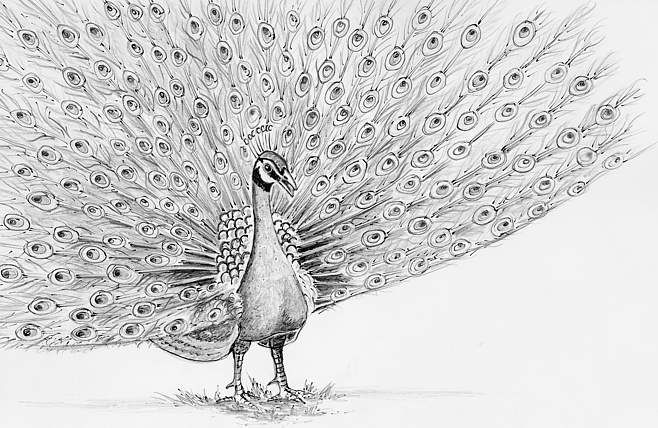
Dear Bird Folks,
The other day I stopped at a local farm stand. While I was waiting in line to pay for my quart of blueberries, I heard an awful scream coming from the adjacent woods. It sounded like someone or something being killed. The sound frightened me, but no one else in line even blinked. When I asked the little farm stand clerk about the scary sound, she said with an expressionless face, “Peacock. Would you like your berries in a bag?” I was too nervous to ask any more questions, so I’ll ask you. Was the clerk telling the truth? Are peacocks really living in the woods of Massachusetts? Do they really make that awful sound?
-Rena, Chelmsford, MA
You can relax Rena,
You are perfectly safe. Everything is fine. Peacocks do make a loud “awful scream.” There is nothing wrong. You don’t have to call CSI: Farm Stand. The real question here is: Did you take a bag for your berries? Now that would be a real crime. All day long I have people who request a bag for everything they buy including bird feeders. A bird feeder in a bag? Bird feeders are used outside and are subject to attacks from snow, squirrels, rain, squirrels, wind, squirrels, sun, squirrels and squirrels. Somehow, I think a feeder could safely make a ten minute trip home, on the front seat of an air-conditioned SUV, without being kept in a bag. Sorry, the summer heat must be getting to me.
Peacocks are one of the most ornate and one of the most recognizable birds in the world. Yet few people know much about them except that they are huge birds, have crazy looking tails and one of them made a fortune working as the logo for NBC. One characteristic of peacocks, that many people don’t know, is that the male has a very loud, and sometimes scary sounding call. His call, which can be heard over great distances, may be heard any time of the year, but most often during the mating season or when someone steps on its long tail.
Another odd thing about peacocks is that their name isn’t really “peacock.” What? The bird more accurately has the boring title of “Common Peafowl.” The male Common Peafowl is the one that is the true peacock. The female is the “peahen.” The young birds are “peachicks.” The stupid birds are referred to as “pea-brains.” If a peafowl couple gets divorced they are called “split-peas.” And if the divorcee marries a pig she is called a “split-pea with ham.” Who knew?
The Common Peafowl is native to India and Sri Lanka. You would think that such a large ornate bird would have long ago gone extinct, especially living in such a crowded part of the world. But such is not the case. Wild peafowl can be heard calling throughout much of their native habitat. These crazy looking birds have several things going for them. First of all the Common Peafowl is the national bird of India. That alone must come with some perks, including not being eaten. The bird is also respected by the local religions. Plus, the peafowl is fairly easy to breed in captivity. There was a time when Europeans raised peafowl for food, but once they got a taste of the North America turkey, the peafowl was dropped to the bottom of the menu, just above the Spam loaf.
The peafowl was introduced to the United States many years ago, with wild populations occurring in some locations, including Florida and California. They are a hardy breed. Birds that have escaped from farms or parks have been able to survive in locations as far north as Massachusetts. One of the reasons why peafowl are able to survive our nasty weather is their diet. They eat everything, including nuts, seeds, berries, worms, frogs, snakes and Spam loaf.
You can’t talk about a peacock without mentioning their dramatic, showy tail. The showy part is called the “train,” and isn’t really the tail. The train is actually made up of the feathers near the base of the tail, but we don’t need to get picky at this point. The peacocks that have the fanciest trains have the best chance of attracting the most peahens. Humans also are attracted to those long plumes, for decorations. Luckily for the peacocks they molt those plumes every year, so there is no reason for the greedy people to harm the bird for a few extra plumes.
I’m glad to get your question Rena. A few weeks ago a very nice family came in and asked me a similar peacock question. I wrote down their name and question but of course lost it ten minutes after they left the store. I must have written it down on a paper bag that is now protecting a bird feeder from the air-conditioning of an SUV.